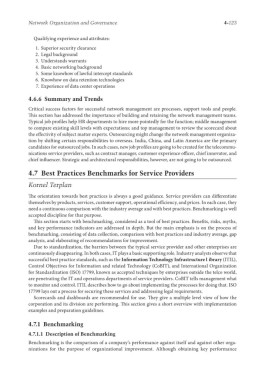Page 592 - Handbook of Modern Telecommunications
P. 592
Network Organization and Governance 4-123
Qualifying experience and attributes:
1. Superior security clearance
2. Legal background
3. Understands warrants
4. Basic networking background
5. Some knowhow of lawful intercept standards
6. Knowhow on data retention technologies
7. Experience of data center operations
4.6.6 Summary and Trends
Critical success factors for successful network management are processes, support tools and people.
This section has addressed the importance of building and retaining the network management teams.
Typical job profiles help HR departments to hire more pointedly for the function; middle management
to compare existing skill levels with expectations; and top management to review the scorecard about
the effectivity of subject matter experts. Outsourcing might change the network management organiza-
tion by shifting certain responsibilities to overseas. India, China, and Latin America are the primary
candidates for outsourced jobs. In such cases, new job profiles are going to be created for the telecommu-
nications service providers, such as contract manager, customer experience officer, chief innovator, and
chief influencer. Strategic and architectural responsibilities, however, are not going to be outsourced.
4.7 Best Practices Benchmarks for Service Providers
Kornel Terplan
The orientation towards best practices is always a good guidance. Service providers can differentiate
themselves by products, services, customer support, operational efficiency, and prices. In each case, they
need a continuous comparison with the industry average and with best practices. Benchmarking is well
accepted discipline for that purpose.
This section starts with benchmarking, considered as a tool of best practices. Benefits, risks, myths,
and key performance indicators are addressed in depth. But the main emphasis is on the process of
benchmarking, consisting of data collection, comparison with best practices and industry average, gap
analysis, and elaborating of recommendations for improvement.
Due to standardization, the barriers between the typical service provider and other enterprises are
continuously disappearing. In both cases, IT plays a basic supporting role. Industry analysts observe that
successful best practice standards, such as the Information Technology Infrastructure l ibrary (ITIL),
Control Objectives for Information and related Technology (CoBIT), and International Organization
for Standardization (ISO) 17799, known as accepted techniques by enterprises outside the telco world,
are penetrating the IT and operations departments of service providers. CoBIT tells management what
to monitor and control. ITIL describes how to go about implementing the processes for doing that. ISO
17799 lays out a process for securing these services and addressing legal requirements.
Scorecards and dashboards are recommended for use. They give a multiple level view of how the
corporation and its division are performing. This section gives a short overview with implementation
examples and preparation guidelines.
4.7.1 Benchmarking
4.7.1.1 Description of Benchmarking
Benchmarking is the comparison of a company’s performance against itself and against other orga-
nizations for the purpose of organizational improvement. Although obtaining key performance

